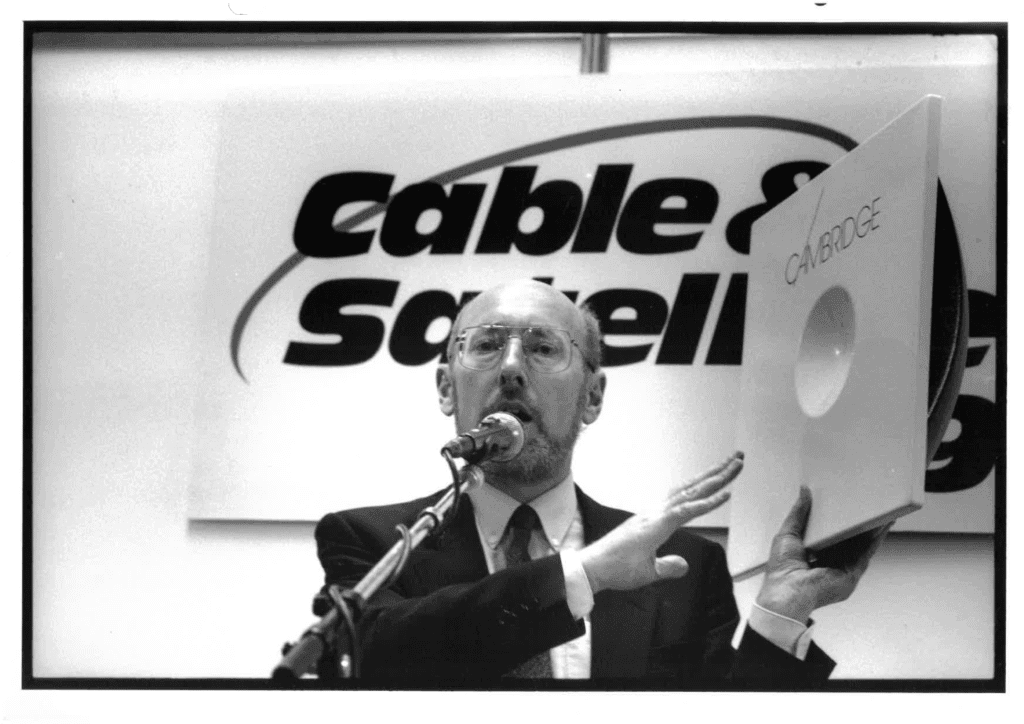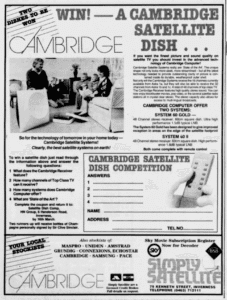Cambridge Satellite Dish
C.1989, Cambridge Computer
This flat, square satellite dish was the second major product of Cambridge Computer, a spin-off from Clive Sinclair’s earlier Sinclair Research. Unlike conventional bowl-shaped dishes, it was enclosed in a shallow plastic case that prevented snow or birds from blocking reception, and was promoted as a “technological breakthrough” after three years of research. The unusual form drew notice, anticipating the “Squarial” dish launched the following year by British Satellite Broadcasting. According to the Sinclair family, both were designed by industrial designer Iain Sinclair, Clive Sinclair’s brother, and though technically different they reflected a late 1980s push to make satellite equipment more discreet and consumer-friendly.
Production was reported to take place at SCI in Scotland, which also manufactured Sinclair’s Z88 portable computer. It was offered in two sizes—60 cm for general use and a more compact 45 cm version for southern parts of the UK—depending on the satellite signal’s coverage. They formed the basis of a range of three receiver systems, two of which were referred to as the “System 60 Gold” and “System 60 II”, marketed as cheaper than Amstrad’s rival products and offered with options such as remote control and stereo sound.
The dish was developed for Rupert Murdoch’s new Sky Television service, launched in 1989, which broadcast from Astra 1A, a satellite that had been placed in orbit just the previous year. Installed on the outside of the home and linked to a decoder box, it connected to an ordinary television and reportedly gave access to 16 channels at launch, with the promise of up to 48 in future. Although quickly eclipsed by Amstrad and a growing number of competing systems, the Cambridge dish reflects the technological optimism of the ‘satellite wars,’ when affordable equipment promised to bring multi-channel satellite television within reach of ordinary households for the first time.

Clive Sinclair at the Cable & Satellite conference, Olympia, with a Cambridge Satellite Dish, 1989. Photograph: The Daily Telegraph, 16 March 1989.

Press advertisement for Cambridge Satellite Dish, Highland News, 10 March 1990. Image: Highland News / British Library.
Satellite Receiver Cambridge Extra RX480 S
C.1989-90, Cambridge Computer
Part of Cambridge’s satellite system, this receiver was designed to operate with the distinctive flat Cambridge dish, sometimes referred to as the “Squish”. Created to bring multi-channel satellite television within reach of ordinary households, both components were designed by industrial designer Iain Sinclair. This example, marked “MADE IN THE EEC” and fitted with a European plug, reflects plans for wider European distribution; the EEC, or European Economic Community, was the forerunner of today’s European Union and lasted until 1993. The receiver featured a large LED display, preset to receive all available Astra channels and capable of tuning all 48 planned channels from the Astra 1A–C satellites. It offered audio-mode selection, Scart and aerial outputs for external decoders and televisions, and was sold with remote control. Marketed alongside variants simply known as the Cambridge Satellite Receiver or the Cambridge Extra RD480 X, its compact form and competitive pricing made it a distinctive example of early 1990s consumer satellite technology.

Satellite Receiver
Cambridge Extra RX480 S
